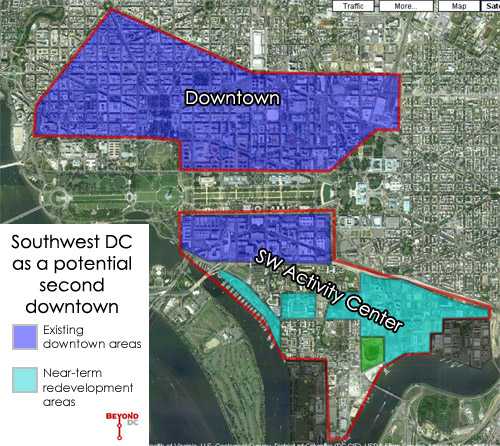Could Southwest become DC’s second downtown?
The Southwest Waterfront master plan, released yesterday, adds to an impressive collection of plans and development that could collectively transform the way we think about the area south of the National Mall.
One day, not too many decades from now, Southwest (and Near Southeast) could become a second downtown for DC, as large as the existing downtown area.

Consider the map above. The teal areas are, from left to right, the Southwest Waterfront, Waterfront Station, and the M Street Corridor, all of which are either rapidly redeveloping or soon will be.
After those areas have developed at downtown-like intensities, it’s likely that the gaps in between will gradually become part of this second downtown as well. The area could ultimately comprise as much as 100 million square feet of residential and office development — equivalent to the existing downtown.
This doesn’t mean existing apartments will be bulldozed wholesale, as the federal government did to create the Southwest Federal Center and L’Enfant Plaza areas. This won’t be a sudden change. Instead, it would happen gradually over many decades, as individual property owners want to redevelop their sites, just as happened at Gallery Place, the Golden Triangle, and the West End and is now happening in NoMA and the Mount Vernon Triangle.
As in those areas, the more historic blocks can be preserved, but only a minority of the buildings in Southwest and Near Southeast are historic. (In large part, this is because the federal government razed the really historic parts of the area long ago.)
Accommodating future development as close to the core of the city as possible is the most efficient, environmentally friendly, and economical way for us to grow. Building a second downtown as close to the Capitol as the existing downtown would be a historically great achievement in Smart Growth, and a far better regional solution than putting that same growth in, say, Loudoun County.
If this is indeed the future of our city, it is a good one. Some people won’t like it, but the alternatives of either pushing growth to the suburbs or tearing down even more historic and well-loved neighborhoods are not acceptable. No where else in the region can we achieve so very much with such relatively little sacrifice.
 Cross-posted at BeyondDC.
Cross-posted at BeyondDC.
